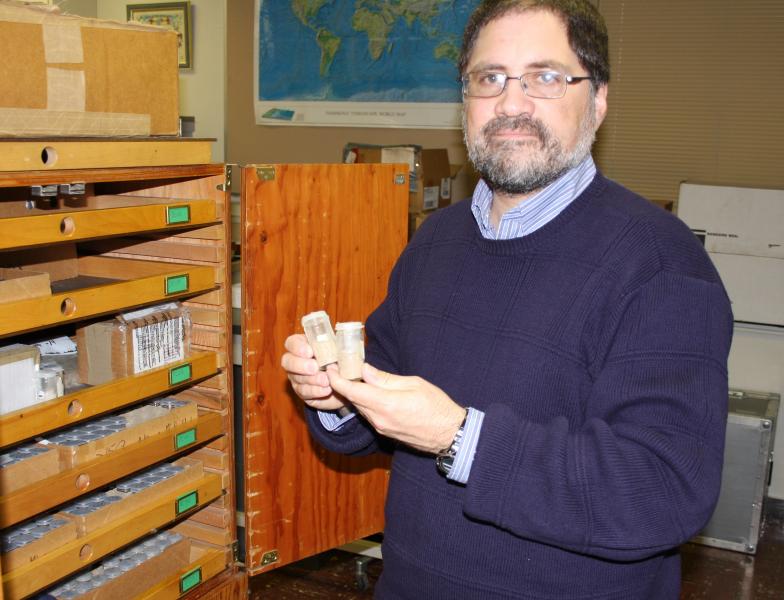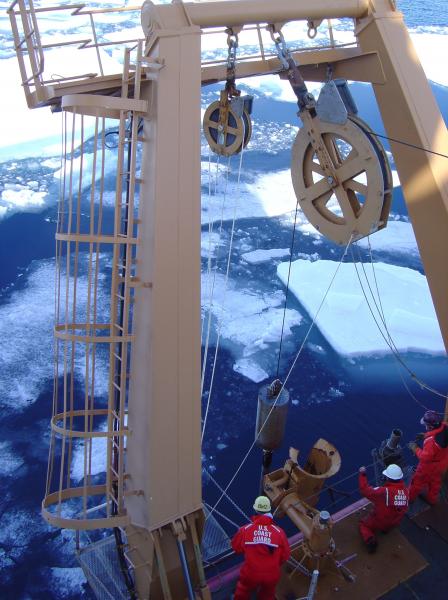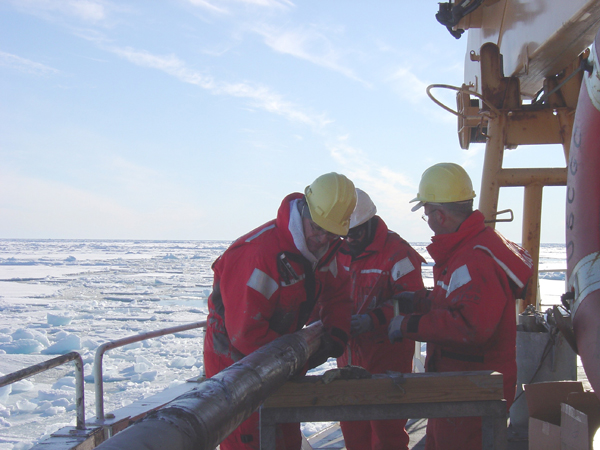The sands of frozen time
Dr. Joseph Ortiz selects a small glass vial from a wooden cabinet. It’s full of sand he says came from the bottom of the ocean, just off the Alaskan coast.
It's part of a sediment core from the North Win Ridge.
Ortiz is a paleo-oceanographer at Kent State University. He studies what oceans used to look like. He says sand like this hitches across the Arctic on icebergs. During the summer, when the ice melts, the sand particles fall, and over thousands of years form layers on the ocean floor. Ortiz says like a passport, the sand has a chemical signature that tells exactly where it’s from.
He says by looking at those trace elements using an electron microprobe, "we can fingerprint those and tie them from the source outcrop where they originally came from.”
Ortiz and colleagues from Old Dominion University and the University of Southern California travelled to Alaska last year and drilled deep into the muck to analyze the pattern of drifting Arctic ice based on sand grain deposits dating back 8,000 years.
A post-glacial climate clock
Ortiz says what his team found, "was a prominent 1,500 year cycle within the Arctic Oscillation, and this hadn’t been shown previously from earlier scientific results.”
 The Arctic Oscillation is caused by wind and ocean currents that flow from Siberia to North America. And it’s during those times of enhanced trans-polar drift that material from the Eurasian side makes its way over to the Alaskan coast. The Arctic Oscillation is caused by wind and ocean currents that flow from Siberia to North America. And it’s during those times of enhanced trans-polar drift that material from the Eurasian side makes its way over to the Alaskan coast.
Ortiz and his team found that this 15-hundred year cycle varies between two extremes. One is the ice-forming positive Arctic oscillation that traps cold air in the north, and the second is the ice-melting negative oscillation that sucks warm air into the pole and pushes cold air south.
Here in the U.S. we feel the negative Arctic oscillation as the Alberta Clipper, these weather patterns that we get here that explain very cold conditions.
Ironically, melting polar ice and the negative Arctic Oscillation bring colder winters and more extreme weather to the eastern U.S. and Europe.
Millennial-old patterns gone awry
While science can’t pinpoint what drives these cycles, Ortiz says the eight-thousand year natural weather patterns recorded in the mud below the Arctic Ocean are now under assault by human activity.
He says what we’re seeing since the 1860’s or so is a long-term trend, "a drift if you will, and that drift is driven by the amount of CO2 that’s being put into the atmosphere.”
While the cycle Ortiz revealed shows the Arctic should be building ice, the opposite is happening.
Ortiz and other climate scientists can’t explain what’s driving the variability we’re seeing through natural causes alone.
Ortiz’s says weather models based on natural forces alone, such as Arctic ice drift, solar cycles, volcanoes, or ocean currents, don’t match what’s happening today UNLESS greenhouse gases are added to the equations. THEN climate models reflect the data of a warming planet and the disrupted Arctic cycle.
The evidence for human caused climate change is overwhelming, according to Ortiz - "If you look at the data from many different angles, from many different fields, it says pretty convincingly that humans have modified the climate system. We need to be paying attention to that.”
The Intergovernmental Panel on Climate Change, the international body of scientists tracking climate data since 1988, says the Arctic Ocean is thawing so quickly, it could be entirely ice free by mid century.
And with no ice at the North Pole, Santa won’t be the only one left out in the cold. |